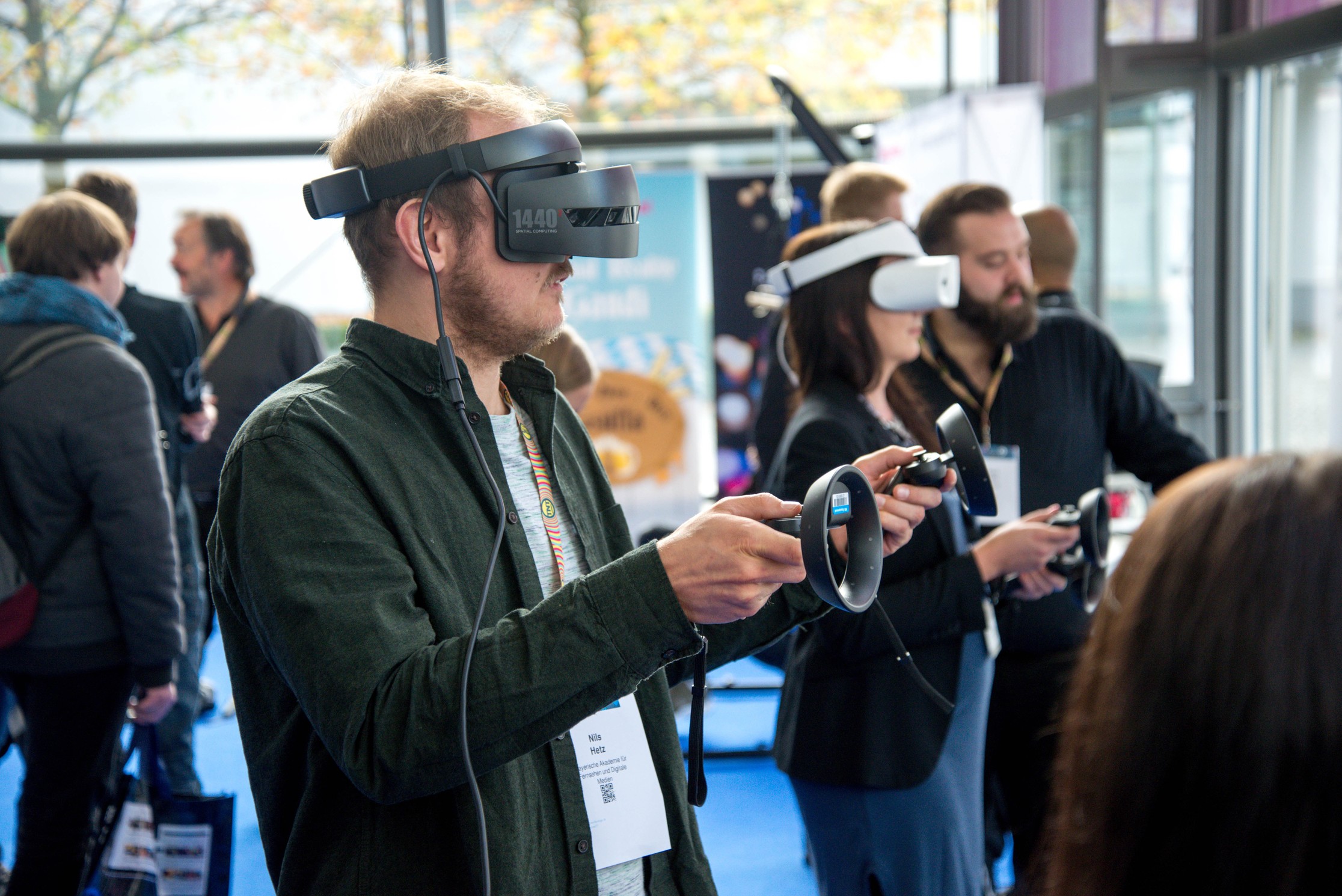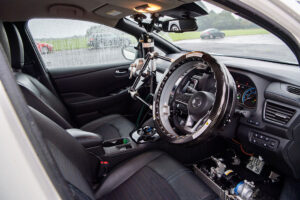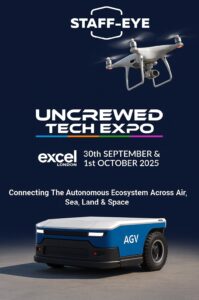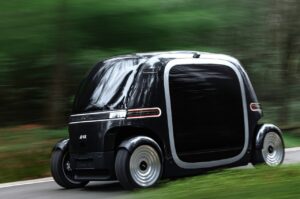In recent years, the new technologies have prevailed in many industries. As the world market is becoming increasingly dynamic, large companies are looking for digitized and consumer-oriented business models. One of the innovations that is currently on the rise in the automotive sector is Extended Reality or XR.
Extended Reality: AR, VR und MR
Extended Reality is a generic term that describes an artificially created environment that connects the real and the virtual world. The term encompasses virtual, augmented, and mixed realities that differ in the level of immersion of the user.
Augmented Reality or AR connects certain digital content with existing reality and thus enables users to partially immerse themselves in the virtual world.

In contrast to AR, virtual reality or VR replaces the real environment with an artificial one, by ensuring total, visionary and sensory immersion.
In Mixed Reality or MR, users interact with a new environment created by the merging of real and virtual worlds.
XR and automotive industry
XR technologies are becoming increasingly important in all industries. According to statistics, the global AR-VR market was estimated at $ 12 billion in 2018 and is expected to increase to $ 192 billion by 2022.
In the rapidly developing automotive world, companies are under enormous pressure from constantly new, groundbreaking innovations. In order to always be one step ahead, vehicle manufacturers not only have to follow the new market trends, but also anticipate and anticipate them.
The dynamism of the automotive sector shows the highest investment rate in AR technologies, which can be seen from the following PWC estimate.

Accessibility of immersive experiences
The rapid technological advances the world is currently experiencing include the full potential of XR-based technologies, and the relative affordability of hardware and development frameworks opens up a wide range of opportunities for XR application.
The fast connectivity achieved through the introduction of 3G, 4G and 5G networks has increased processing performance more than ever. For example, the iPhone X has become six times faster than the first models appeared on the market. Digital cameras are also changing, adding additional functions and improving the old ones. A comparison of the properties of the iPhone 3GS and X video cameras, which have 60 fps rendering, 12 megapixels and the iPhone 3GS only 30 fps rendering or 3.2 megapixels, shows the technological progress clearly. The mass adoption of XR applications in many industries is not only due to their ability to ensure higher quality, but also because AR and VR devices are becoming cheaper. With the development of intelligent sensors, real-time object recognition, visual positioning and cognitive recognition are becoming increasingly efficient. Mature sensor systems are spreading IdD technologies (Internet of Things technologies) very quickly and at the same time increasing the need for faster, more intuitive interactions and visualizations.

The importance of XR-based technologies for automotive companies
VR and AR applications are revolutionizing the entire value chain, from R&D to manufacturing, marketing and after-sales to the product itself. Many large automotive supply chains implement AR and VR technologies as part of their R&D and design processes. AR’s most effective applications include prototype testing at end customers, VR remote developments and VR-controlled self-driving tests. On the other hand, VR technologies are increasingly used in the R&D area, since they are mostly used for training purposes and remote manufacturing.
The augmented reality is also used in the manufacturing and delivery area. With the ability of AR and VR to map complex objects and to analyze the technical consequences of clashes, the automotive industry is effectively using unlimited application possibilities of XR in practice. Some of the applications are AR training, smart glasses assistance in SCM and production, AR-embedded quality control, advanced control of the production line, AR-controlled image processing in logistics, virtual factory twins, and virtual remote control of the Production.
As a result of increasing digitization, the automotive market is increasingly geared towards the consumer. Automotive companies strive to develop more personalized marketing models to satisfy their audience. By using XR solutions, the car manufacturers offer their customers extended and virtual car configurators, the demonstration of exterior car accessories, etc.
Test drives and virtual showrooms
XR-based applications are also used in the provision of after-sales services. The most important use cases include paramedic apps, virtual technical manuals and extended damage analyzes.

The most important use cases: Virtual Prototyping, Augmented Training, Immersive Showrooming.
Virtual Prototyping
Today customers are looking for more fuel efficient, greener, safer and more reliable cars. In order to meet customer requirements, automotive companies have decided to take more innovative approaches. Implementing VR-based automobile prototypes can help automakers better model vehicles in terms of volume, size, and distance. VR embedding enables engineers to interact directly with the virtual vehicle prototype and get a better overview of all of its systems so that they can identify design errors at an early stage. Virtual prototyping enables automotive engineers to correct errors in real time directly on the prototype, which speeds up development time, improves productivity, reduces costs and delivers a better product.
- Ford
Ford Motor Company has been using VR-based technologies in various phases of its development processes since 2000. Instead of creating expensive physical models, Ford is now actively using VR for vehicle design by using VR headsets.

“What we are looking for is the quality of the vehicle that a customer imagines,” said Elizabeth Baron, virtual reality and advanced visualization technical specialist at the company, Forbes. “We want to be able to experience the cars and our designs before we actually produce them.”
Augmented training
AR was also used in the transformation of training processes to make them more efficient and automated. With an AR device, automotive companies can recreate every possible real situation without the risks that can occur in real life. By using devices such as AR glasses, headsets or tablets, AR training applications can enable employees to see processes and procedures in real time, step by step.
- Jaguar

Jaguar Land Rover (JLR) has successfully introduced AR technology into its training programs that enables trainees to be trained without having to reposition or disassemble the Jaguar vehicles dashboard. With AR applications, employees can visualize JLR-internal data with individual components from different angles on a tablet. This solution helped the company reduce costs, increase efficiency and improve the quality of JLR vehicles.
Immersive showrooming
Today VR and AR technologies are changing the way vehicles are sold in the automotive trade, and at the same time improving the customer experience. In the digital age, customers no longer have to go to a car dealership to buy a car. Innovative digital showrooms make buying a car more accessible and attractive for customers and easier and cheaper for car dealers.

According to V12 Data’s research, 70% of the younger generation consider new technologies and infotainment functions to be extremely useful when buying a car.
In a virtual reality showroom, customers can sit on an armchair that feels like the real car seat and enjoy a real-time experience of the car in a 3D 360-degree virtual environment using a VR headset. In addition, a potential customer can virtually search through all possible equipment options and colors and configure the equipment of the desired vehicle himself. Because test drives are offered in a completely virtual reality, they attract more customers, lower the cost of car traffic and enable companies to get more first-hand feedback.
- Audi
The Audi dealer network has used functional VR applications for customer advice. One of the smallest Audi dealers in Great Britain, London Audi City Showroom with a total area of only 420 square meters, offers its customers a realistic experience of their individually configured vehicle in every detail by implementing a VR-embedded application.
“With the VR experience, we have developed a full-fledged sales tool for Audi dealers. It offers our customers more information and security when making their purchase decision, as well as a special stimulus factor, ”says Nils Wollny, Head of Digital Business Strategy / Customer Experience at AUDI AG. “This is the next step in our strategy to combine digital innovation with the brick and mortar business.”
Other XR applications
In the vehicle
- Holographic AR Navigation Systems: Hyundai
South Korean auto giant Hyundai Motor, which has long been associated with innovation, has also used AR and VR technologies in its business. Hyundai recently launched its AR navigation system, which is equipped with the Genesis G80 sedan. The system provides the driver with information, destinations, navigation information and holographic image warnings on the windshield that are perceived as part of the route.
Outside the vehicle
- AR-Manuals: Mercedes
Mercedes-Benz uses AR technology to help its customers better understand vehicle devices. The AR manual provides the user with step-by-step virtual guidance that helps reduce many complexities. With Ask Mercedes, an AR app from Mercedez-Benz, users can scan a machine or certain controls and displays in a vehicle and identify all embedded functions. With this solution, Mercedes customers can do without long text descriptions and instruction videos.
Vehicle creation
- Planning of production sites: BMW
BMW Group production has long focused on augmented reality. With the implementation of XR, BMW enabled the fitters to evaluate the entire production in a virtual environment and to test new processes in 3D.
Matthias Schindler, responsible for virtual planning and implementation in production at the BMW Group, said: “Virtual reality technology has enabled us to quickly and efficiently set up cockpits in the area of workplace systems for assembly technology. Time-consuming test installations that depict the actual dimensions of the workstation were no longer necessary. And the fact that all the specialists involved – from the logistics expert, through the system planner, to the production employee – were able to exchange information with one another in the early phase without any problems was an important additional advantage for the team. Overall, we were more transparent, flexible and faster.
#XR #Automotive #staffeye




